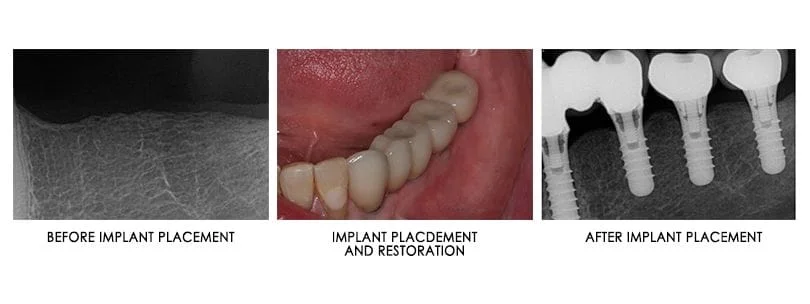DENTAL IMPLANTS
Congratulations on your decision to have dental implants.
Dental implants today have a proven success rate. If you have lost any of your teeth, or wear any types of denture, dental implants may offer many benefits. You will be able to eat easily, comfortably and confidently. You will notice an improvement in your appearance. And you will no longer be inconvenienced by loose-fitting dentures.
Dental implants can improve the way you look and feel about yourself.
Dental implants are small titanium fixtures that are placed in the bone of the upper or lower jaw. The implant bonds with the bone and acts as an anchor for replacement teeth. Think of them as tooth roots.
Dental implants can be used to replace a single lost tooth or many missing teeth. Several options are available to restore your lost teeth; our team will discuss these with you in detail.
Patients who have chosen implant supported teeth report that they are happy and comfortable for the first time since the loss of their original teeth.
Your diagnosis for dental implant treatment will include x-rays, study models, measurements, a clinical exam and an evaluation of your medical conditions, as well as consultations between Dr. Amjad Aldallal and your general dentist. It is necessary to be as thorough as possible in this initial planning phase to increase our chances of long term success and satisfaction.
Together with you and your family dentist, we will determine which type of restoration is best for you. Options include crowns for single tooth replacements, fixed bridges for multiple missing teeth and securely retained dentures. Each option will be carefully evaluated for your individual case.

When dental implant can be placed surgically?
Dental Implant can be placed surgically in several possible ways:
- Immediate Implant Placement: Dental Implant will be placed immediately after tooth extraction. Bone Grafting and Resorbable Membrane ( called Guided Tissue Regeneration GTR) will be used at the same time to augment the bone structure around the implant to improve the success rate of implant.
- Delayed Implant Placement : Dental Implant will be placed after several months (2-3) of tooth extraction. In most cases, bone graft and GTR will be used after tooth extraction to minimize bone loss ( width and height ) and to improve the surgical outcomes of implant placement.
- Implant placement in already missing tooth site: Dental Implant will be placed in already missing tooth site. Based on clinical exam and x-rays will be decided to use bone graft and GTR along with implant placement.
What are the procedures that need Bone Grafting for implant placement?
Sinus Lift
The maxillary sinuses are behind your cheeks and on top of the upper teeth. Sinuses are like empty rooms that have nothing in them. Some of the roots of the natural upper teeth extend up into the maxillary sinuses. When these upper teeth are removed, there is often just a thin wall of bone separating the maxillary sinus and the mouth. Dental implants need bone to hold them in place. When the sinus wall is very thin, it is impossible to place dental implants in this bone.
There is a solution and it’s called SINUS LIFT or SINUS AUGMENTATION. The dental implant surgeon enters the sinus from where the upper teeth used to be. The sinus membrane is then lifted upward and donor bone is inserted into the floor of the sinus. Keep in mind that the floor of the sinus is the roof of the upper jaw. After several months of healing, the bone becomes part of the patient’s jaw and dental implants can be inserted and stabilized in this new sinus bone.
The sinus lift procedure makes it possible for many patients to have dental implants when years ago there was no other option other than wearing loose dentures.
If enough bone between the upper jaw ridge and the bottom of the sinus is available to stabilize the implant well, sinus augmentations and implant placement can sometimes be performed as a single procedure. If not enough bone is available, the Sinus Augmentation will have to be performed first, then the graft will have to mature for several months, depending upon the type of graft material used. Once the graft has matured, the implants can be placed.
Ridge Expansion
In severe cases, the ridge has been reabsorbed and a bone graft is placed to increase ridge height and/or width. This is a technique used to restore the lost bone dimension when the jaw ridge gets too thin to place conventional implants. In this procedure, the bony ridge of the jaw is literally expanded by mechanical means. Bone graft material can be placed and matured for a few months before placing the implant.
Ridge ( Socket) Preservation
Careful management of extraction sockets after tooth extraction prevents unsightly bone loss and provides a better cosmetic outcome for tooth placement. Bone Graft and GTR will be used at the same time of tooth extraction. After several months, Dental Implant will be placed.

